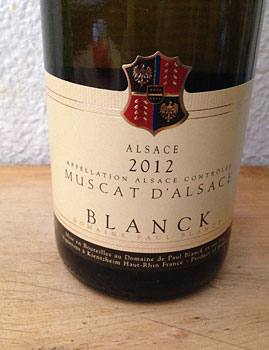| « Previous | News | Next » |
July 15, 2015
Summer Sipping Primer 2015: Weirdo Whites
 Let 2015 be the summer of the weird, obscure whites. Let the Garganega be flowing. Give your Chardonnay a break. Put the Sauvignon Blanc back on the shelf. Be that guy or gal who brought the Godello. Let this be your calling card. Spicy mango fish tacos on the menu? Is your best friend roasting a duck? Show them how they do it in Alsace with an ambrosial Muscat. We have a stellar lineup of offbeat wines that are just aching to join you at your next summer BBQ. Here are a few to wet your whistle.
Let 2015 be the summer of the weird, obscure whites. Let the Garganega be flowing. Give your Chardonnay a break. Put the Sauvignon Blanc back on the shelf. Be that guy or gal who brought the Godello. Let this be your calling card. Spicy mango fish tacos on the menu? Is your best friend roasting a duck? Show them how they do it in Alsace with an ambrosial Muscat. We have a stellar lineup of offbeat wines that are just aching to join you at your next summer BBQ. Here are a few to wet your whistle.
Finca Os Cobatos 2013 Godello, Monterrei DO
Godello might be a dark horse in terms of popularity, but it is a light, versatile, fruity grape that makes snappy, high-acid wines. Native to the Galicia region of northwestern Spain, Godello thrives in the cool, maritime climate and lush forests near the border of Portugal. An excellent example comes from Finca Os Cobatos, a side project of the Mendez Family who are known for wines under their Pazo do Mar label.
Their vineyard is located in Monterrei, the driest DO in Galicia, and planted entirely to Godello and the native red grape Mencia. Grapes benefit from elevation at 600 meters, plus well-draining sandy slopes with bits of quartz that reflect the sun’s rays, helping to concentrate fruit. The juice is fermented in tank, aged on its lees, then cold stabilized and filtered before bottling.
This 2013 Godello is nothing short of energetic. A light lemon-yellow in color, aromas of lime, grapefruit, and kiwi prance out of the glass. The palate shows granny smith apple and key lime, then finishes with a long, lusty zip. The effect is like taking a sudden dive into a cold lake on a swelteringly hot day—glorious! Pair with Belizean Shrimp Ceviche for a really winning summer party appetizer.
Le Fraghe 2013 ‘Camporengo’ Garganega, Veneto IGT
Garganega is most famous for its starring role in Soave DOC wines, which earned the reputation of being something like the Pinot Grigio of the 70s—popular, cheap jug wine that even surpassed Chianti in U.S. sales. As with Chianti and Pinot Grigio, its rise in Stateside popularity had inverse effects on quality, with gallons of inexpensive, neutral wines being churned out to be exported. High yields were a big part of the problem; Garganega is a vigorous grape and has a tendency to overproduce, so producers must keep tight control on yields. But in the right hands, Garganega is aromatic and seductive.
Matilde Poggi of Le Fraghe is a producer in nearby Bardolino (about an hour from Soave), who has the magic to make Garganega sing. She is devoted to growing varietals native to this region—Corvina, Rondinella, and Garganega—and, through careful farming and vinification, is able to coax the best out of these grapes. She comes from a long line of vignerons, and grows on an estate that’s been in the family since 1880. Since 2013, she’s been the President of the Italian Federation of Independent Grape Growers. And these bona fides pay off in the glass.
Her ‘Camporengo’ Garganega, named for the village in which it’s grown, is fragrant, and anything but neutral. Warm aromatics of peach, lemon, marzipan, yogurt, and wildflower draw forth from the nose. The palate is full-bodied with creamy stone fruits, and a nice, integrated grip on the finish. This is a sure match for Stone Fruit Gazpacho with Scallops. In the perennial Ginger vs. Mary Ann debate (for all you Gilligan’s Island fans), this plucky wine would surely pick Mary Ann…
 Paul Blanck 2012 Muscat d’Alsace AOC
Paul Blanck 2012 Muscat d’Alsace AOC
…And this one would be captain of Team Ginger. Muscat d’Alsace (AKA Muscat Blanc à Petits Grains) is one of the sexiest grapes out there. Known for being a sensuous powerhouse of perfume, it’s been grown in the Mediterranean for centuries. In fact, it’s ancient; it’s one of the first grapes to ever be identified. It has many variations, but this variety in particular has been recorded in Greece, Roussillon, Corsica, Piedmont, Romania, Australia, South Africa, Germany, and Alsace—the latter is where it still makes its home today. Thanks to small yields and susceptibility to disease, Muscat d’Alsace is hardly a mainstay at the table today. But Paul Blanck’s 2012 version will make a believer out of you.
2012 was a good year for Alsace, with a warm steady August and a cool, dry September that kept vineyard diseases at bay. Muscat d’Alsace thrives in the warmth, and this bottle is effusive. Lychee, passion fruit, jasmine, and a touch of a honey-ginger glaze abound on the nose. It is round and welcoming on the palate, then glides to a bright white-flower finish, like a hula dancer softly placing a lei on your shoulders as you get off the airplane. It has enough acidity to sustain its charms, and a fairly dry finish, making it an excellent pair for food. It’ll work with a charcuterie plate, but also be a boon companion to anything tropical and spicy like this Mango and Coconut Rice Salad.
The Blanck family is historic in Alsace, as the first folks to acquire vines in the region back in 1610. Many generations later, the 36-hectare domaine (which includes 5 Grand Crus) is in the hands of Frédéric and Philipe Blanck, who have great respect for the vines and the soil and have worked to create a natural ecosystem in their vineyards. Their objective is to “create wines of pure pleasure,” and this Muscat d’Alsace is indeed pure hedonism.
Written by Kate Soto
